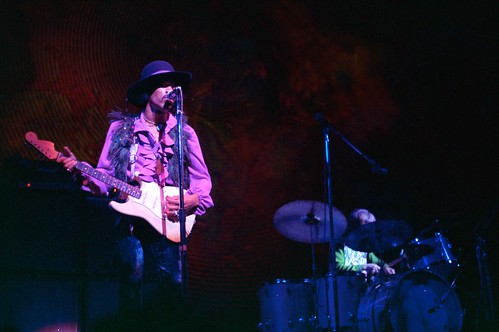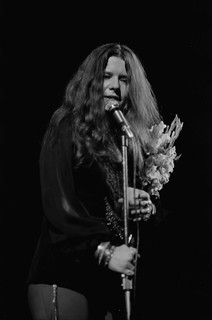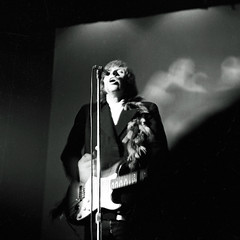There wasn’t any fanfare about it, but the Fillmore East would’ve turned 45 last month. On March 8, 1968, the 2,700-seat concert hall opened its doors with the first of two shows featuring rockers Big Brother & the Holding Company with Janis Joplin, folk singer Tim Buckley and blues guitarist Albert King.
San Francisco promoter Bill Graham had taken over the Village Theater at 105 Second Avenue the previous year. It had seen better days: opened in 1926 as the Commodore Theater, the playhouse was one of many along Second Avenue, the “Jewish Rialto” where the greats of the Yiddish stage performed. The Loews Corporation later operated the Commodore as a movie house until it became the Village Theater, which revived its history of live music and comedy but eventually operated in a state of disrepair and soon closed.
By 1967, Mr. Graham had successfully launched the Fillmore Auditorium and later the Fillmore West: San Francisco venues where blues, jazz and roots musicians shared the bill with the leading rockers of the era. In a run that lasted just over three years, the Fillmore’s East Village outpost – the history of which we’ve delved into a few times before – presented rock royalty like Jimi Hendrix, Led Zeppelin, Elton John, James Taylor and Derek and the Dominos.
Mr. Graham long maintained that the Woodstock Festival dramatically changed the rock concert industry. As performers’ fees skyrocketed, only arenas and stadiums could afford to book the rock stars of the 1970s. Admittedly burned out, Mr. Graham closed both Fillmore East and West in 1971.
The artists who performed at the Fillmore East fondly remember what was once called “the church of rock ‘n’ roll.” The hall’s intimacy, acoustics, psychedelic light shows and enthusiastic fans all contributed to a lasting affection for the Fillmore East 45 years after its opening.
Here are some remembrances.
Steve Miller
It was going to be my first time headlining at the Fillmore East. It was real important to me.
So I get to New York, I’m very excited, I’ve played, I’ve worked my way up, I did the show with Miles, I did the show with Neil Young, and now I’m finally getting to headline my show [with Mungo Jerry].
And I get to town and I go by the Fillmore East and the billboard says, “Miller Mungo.” And I liked Mungo Jerry, I thought they were kind of funny. I liked the tune, you know, but I was very upset, right? And we go and play the gig and as soon as they finish their set, they throw out about 500 kazoos into the crowd and leave the stage. I mean that’s what working with Bill Graham was like.
The Fillmore East was Bill Graham. He had this big ego. He was the most important promoter in the world; he would tell you that every minute of the day and he generated that kind of juice and that kind of excitement and then he delivered it in a really big way. Of course, it was wonderful.
He had learned so much in San Francisco and that whole scene had developed so beautifully that you see when you sit down and look at the lineups that played at the Fillmore East or at the Fillmore West, that was probably the greatest melting pot of music in the history of civilization.
More than 40 years since its start in Berkeley, California, the Steve Miller Band continues to perform its blues-rock hits like “The Joker” and “Abracadabra.”
John Mayall
If you played there, you did feel like you were a part of something whereas the bigger places, of course, everybody gets lost in the shuffle. Stadiums are stadiums, it loses the intimacy. So because of the size of the place it was just about right. It held a lot of people but not too many people that you couldn’t feel that connection with the artist.
Bill Graham was very much a stickler for getting everybody on time and treating them with respect and treating them well. As long as you toed the line and did what you were supposed to do, he was a great promoter to have.
John Mayall helped launch the careers of musicians like Eric Clapton and Mick Fleetwood, who were members of John Mayall’s Bluesbreakers. Though he has retired the Bluesbreakers name, Mr. Mayall continues to record with a new band.
Jerry Miller
One night we played, we went out there, it was the last time we played there, of course, because we had this idea, we were going to go out and sit down and play. And Bill Graham said, “All right, all you guys need is coffins.”
He liked me but he hated the Grape. He thought that was the biggest stack of adult delinquents he’d ever seen.
He liked me because I was always on time and way early. And he liked that. He was a businessman. He couldn’t stand anybody not following through on an agreement. You wanted to get on the wrong side of him, just show up late. I really miss him and I wish he were still around.
Jerry Miller was the lead guitarist of Moby Grape, the seminal 1960’s Bay Area band whose eponymous debut album remains a classic. Mr. Miller lives in Tacoma, Washington, where he performs with the Jerry Miller Band.
Country Joe McDonald
I don’t know why that I decided that we should go to the Fillmore during the day and play naked. Play naked and they would take some still photographs, looking for that great photograph.
What I didn’t realize was that I was the only person that didn’t have an instrument in front of them, so I’m completely just frontal nudity there.
It was during the day and what I didn’t know was that Joshua [Joshua White of the Joshua Light Show] filmed 16mm film of that. And the next time we played the Fillmore, when we did “Fixin’-To-Die Rag,” Joshua projected behind us the naked band dancing around and playing. I remember as we were singing “Fixin’-to-Die Rag” the audience was not looking at us, they were looking up over our heads and I remember turning around and seeing the projected image of us playing naked.
As the leader of Country Joe & the Fish, Country Joe McDonald wrote one of the most memorable anti-war songs of the 1960’s: “I-Feel-Like-I’m Fixin’-To-Die Rag.” Mr. McDonald, who lives in Berkeley, California, today writes and performs as a solo artist.
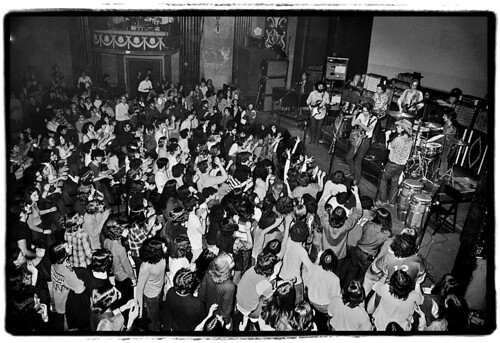 The Grateful Dead at Fillmore East, January 2, 1970. See more of Amalie R. Rothschild’s photos here.
The Grateful Dead at Fillmore East, January 2, 1970. See more of Amalie R. Rothschild’s photos here.Roger McGuinn
I have a couple of good memories of the Fillmore East. One of them was the first time Clarence White was exposed to the audience at the Fillmore East. They’d seen the Byrds before with various other people in the band and when Clarence and I started playing, Clarence was just so amazing, he was like having Jimi Hendrix in your band. It just killed the audience. They were totally blown away. It’s like having a loaded machine gun. It was an amazing experience because they’d come to expect a certain level of quality from the Byrds over the years and Clarence was just so far above that that it was an amazing feeling to be on stage with him. Everybody got really excited about the whole thing.
Roger McGuinn is the co-founder of the Byrds, who pioneered folk-rock with songs like “Turn! Turn! Turn!” and “Mr. Tambourine Man.” Mr. McGuinn, now a solo artist, records traditional folk songs available on his Web site.
Jesse Colin Young
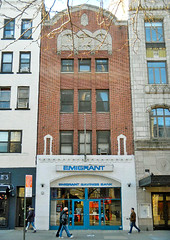 Frank Mastropolo Its façade remains, but the rest of the
Frank Mastropolo Its façade remains, but the rest of theFillmore East was demolished in 1996.
Its lobby space is now a bank.
It was strange, I’m a New Yorker and we moved to San Francisco.
The Youngbloods moved there I think the early fall of ’67. We went there to play for the first time in the late spring and caught the beginning of the Summer of Love.
Then we came back to New York to the Fillmore East and all of a sudden the New York audiences were like the West Coast audiences. They weren’t reserved, they kind of cracked. That was a whole different side of New York that I had never seen, New York audiences. In that way, it was like stepping into Fillmore West. You know what I mean? The whole atmosphere, the way the people acted, the way the place was run and of course part of that is a testament to Bill.
To play with Iron Butterfly and then Zappa, I loved it. I think people loved it. It was Bill’s kind of signature thing. To put the Youngbloods with Chicago, well, that’s one thing, but you can have jazz and blues, Charles Lloyd, and to mix that with Zeppelin, yes, I don’t remember really playing on those kinds of bills except with Bill Graham.
Jesse Colin Young founded the Youngbloods, whose song “Get Together” was a call for peace in the turbulent 1960’s. Mr. Young, who lived on St. Mark’s Place in 1962, now calls Aiken, South Carolina home. Now a solo artist, Mr. Young has performed in support of environmental accountability and quality education.
John Kay
One particular Easter, one has to remember the context of the times, just before we’re going on — keep in mind, I’m legally blind so my vision is not the best. So where the hell is Nick the bass player? It’s time to go. Everybody else is onstage.
Well, he finally appears and he appears dressed in a sequined jock strap and some bunny ears.
It just got into his head, it being Easter and everything else, this would be something new, exciting and different. Well, you know, I remember our drummer saying, “I could see the steam coming out of John’s ears.”
Bill regularly would kind of play, I don’t want to say teacher but he was like a musical professor who would go out there on the stage and say, “Now I want you to know that you’re in for a treat because this man who’s about to take the stage is one of the icons of the blues.”
I think he just saw the opportunity of these kids; you give them a light show and you get a decent sound system in here and bring some music they can relate to, this works. And every so often, I could slip them an act; there’s three acts a night, and they usually played twice each night. I can introduce them to some other things that they might have never heard of. Something from the South, or some East Coast act or whatever. And it just caught on.
John Kay, lead singer of Steppenwolf, is the voice of rock anthems like “Born to Be Wild” and “Magic Carpet Ride.”
Mark Farner
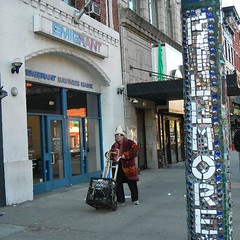 Frank Mastropolo The corner of Second Avenue and Sixth Street was
Frank Mastropolo The corner of Second Avenue and Sixth Street wasnamed Bill Graham’s Way in 1994. A street sign
and a lamppost mosaic by Jim Powers pay tribute.
The first time we were there, it’s electrifying. The place, the way it was laid out, the stage and the audience, there was not a bad seat anyplace. It was a close audience and I love that feeling. There was a lot of love that night, it was pouring out. I’ll never forget that.
It was the second time we played the Fillmore, my manager at the time, Terry Knight, was walking the band back to the dressing room. But he had never taken the lead before. He’d always follow behind the band and security would lead us off to the dressing room.
So Terry opens the dressing room door and here’s Jimi Hendrix standing there with his hat on. Got this little grin on his face. And I just walked up to him and I hugged him and just said, “You’re a great guitar player!” Could you imagine all of the things I could have said? I tell him he’s a great guitar player. This is my guitar god standing in front of me. Man, I’m just so taken away at that point, you could have blown me over with a feather.
In a setting like the Fillmore, it’s very concentrated compared to Shea Stadium. Your stage is set up at second base, you’re not that close anymore. And you can’t get the coziness that you had because there’s a lot of air between you.
To hear your instrument and your vocals and everybody out in the audience is getting a good mix, man, that’s rock ‘n’ roll.
People, they try to relive Woodstock, they have another Woodstock, but I’m telling you the Fillmore East was for that time a very important part, very significant to the fabric of rock ‘n’ roll.
Mark Farner was lead singer and guitarist of power trio Grand Funk Railroad, who had hits like “We’re an American Band” and “I’m Your Captain.” Mr. Farner continues to write and perform as a solo artist.
East Village resident Frank Mastropolo is a freelance journalist and former television network news producer. You can find more of his rock concert photography here.



